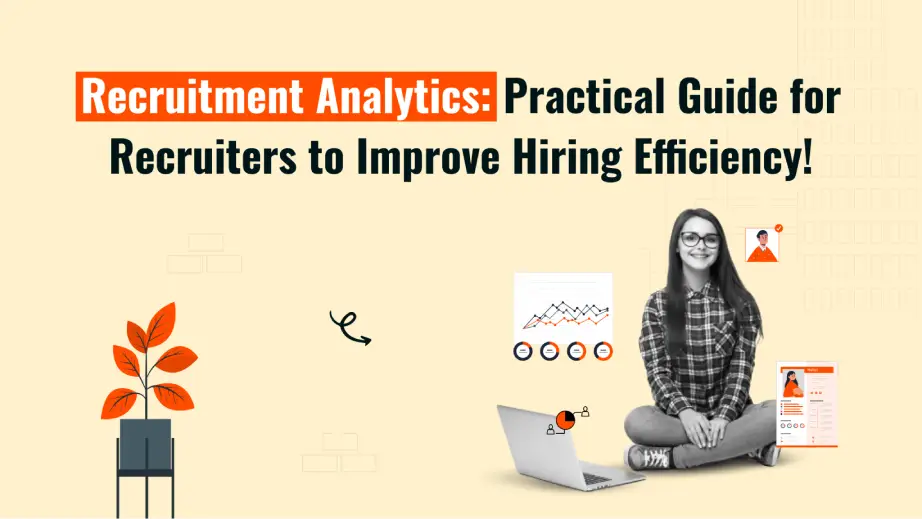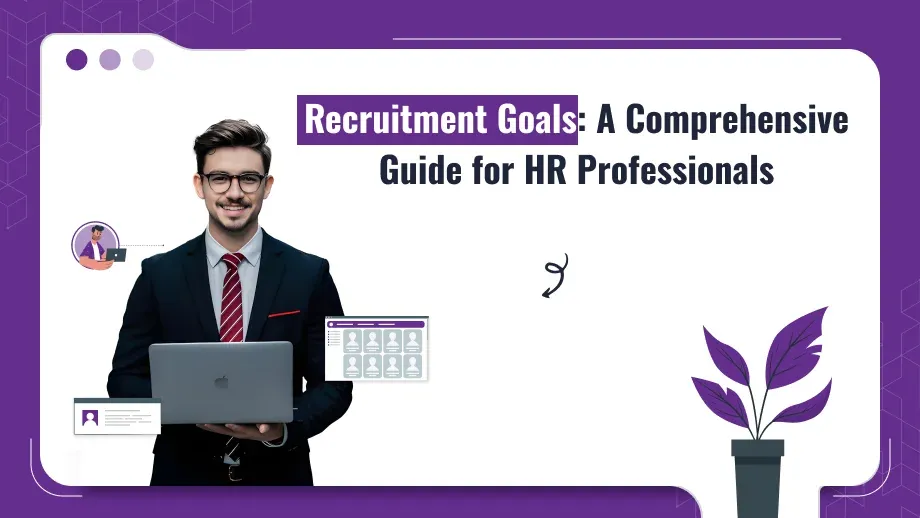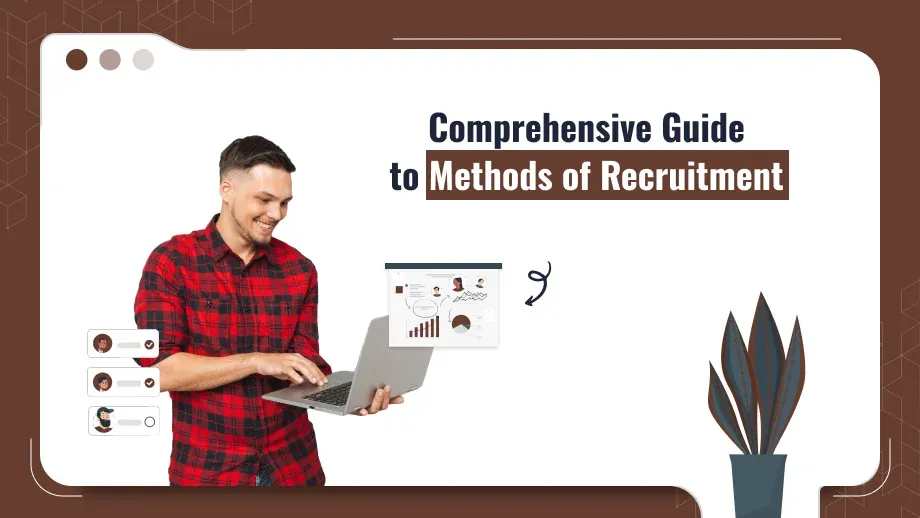Grab a chance to avail 6 Months of Performance Module for FREE
Book a free demo session & learn more about it!
-
Will customized solution for your needs
-
Empowering users with user-friendly features
-
Driving success across diverse industries, everywhere.
Grab a chance to avail 6 Months of Performance Module for FREE
Book a free demo session & learn more about it!
Superworks
Modern HR Workplace
Your Partner in the entire Employee Life Cycle
From recruitment to retirement manage every stage of employee lifecycle with ease.


Seamless onboarding & offboarding
Automated compliance & payroll
Track performance & engagement
Recruitment Analytics: Practical Guide for Recruiters to Improve Hiring Efficiency!
- talent acquisition dashboard
- 19 min read
- June 26, 2023

Do you wish to transform your recruitment process and elevate your hiring game to new heights? If you said YES, you’re just at the right spot right now!
Gone are the days of relying solely on instinct and experience to make hiring decisions. Businesses today have recruiting analytics – the game-changing data science that empowers the recruiting industry.
With recruitment analytics, you can harness the power of data to measure and optimize your Recruiting Pipeline effectively.
In this blog, we will explore everything about recruitment analytics, and understand the right techniques to get error-free as well as actionable insights for your recruiting processes.
So, let’s dig deeper and unlock the potential of data-driven recruitment strategies and revolutionize your hiring game.
What is Recruitment Analytics?
Recruitment analytics refers to the utilization of people analytics to monitor, manage, and evaluate various metrics associated with the hiring process. This encompasses sourcing, selection, and hiring procedures, as well as assessing the overall impact of new hires on retention and turnover rates, often guided by a requirements gathering template.
The primary objective is to identify bottlenecks and areas that require enhancement, enabling the streamlining of your hiring process and the provision of a superior candidate experience.
For instance, if a significant number of newly hired individuals leave the organization within the initial three months, it may indicate underlying issues within the hiring cycle, such as selecting unsuitable candidates or failing to provide an effective onboarding experience.
To conduct a comprehensive analysis of these metrics, it is crucial to gather extensive information concerning the recruitment funnel and its implications for the business. Various sources can be employed for this purpose.
The right Applicant Tracking System will provide valuable insights into selection and recruitment processes.
Likewise, performance management software allows the determination of a new hire’s ramp-up time, assessing how quickly they become productive members of the team.
Additionally, employee satisfaction surveys can be utilized to evaluate the effectiveness of the hiring process. Once all the relevant data has been collected, it can be analyzed to develop strategies for improvement, as we will explore in the following sections.
Now that you know what is recruitment analytics, let’s understand its importance!
Why is Recruitment Analytics Important?
The significance of recruitment data analytics in HR departments is steadily increasing in today’s business landscape.
A recent report by Deloitte highlights that 71% of companies consider talent analytics a crucial focus area.
For instance, a GTM headhunter can leverage these analytics to identify the most promising candidates, tailor recruitment approaches, and make more informed hiring decisions that align with the company’s strategic goals.
By leveraging recruitment analytics, organizations can find answers to critical questions such as:
1. What is the average cost per hire?
2. How much time do you invest to fill an opening, on average?
3. Does the candidate’s experience reflect positively on the company?
4. What is the revenue generated per hire?
5. Are the offer acceptance rates satisfactory?
6. Is the quality of hire aligned with expectations?
Monitoring and Evaluating Recruitment Analytics on a regular basis provides significant insights that Improve Recruiting Process and provide a variety of hiring insights.
Efficient hiring processes not only attract high-quality talent but also foster loyalty and productivity among new recruits, thereby contributing to the achievement of company objectives and the enhancement of overall business operations. Ultimately, these improvements have a direct impact on the organization’s bottom line.
What are Recruitment KPIs?
Recruitment Key Performance Indicators (KPIs) provide valuable business insights that empower HR professionals to optimize the recruitment process, elevate their performance, and boost productivity.
By leveraging real-time insights, HR teams can make informed hiring and recruitment strategic decisions to effectively achieve their recruitment objectives.
These valuable insights play a crucial role in establishing a robust HR process, ultimately fostering sustainable development for the company and its resources. In the following sections, we will delve deeper into the specific learnings that can be derived from these indicators and explore the valuable assistance they can provide.
What are Recruitment Dashboards?
A recruitment dashboard serves as a valuable analytical tool for monitoring, tracking, and analyzing various aspects of your hiring initiatives. By utilizing a combination of key performance indicators (KPIs), you can identify trends and patterns that will optimize your hiring and recruitment strategy, ultimately yielding the best results.
In addition to enhancing your hiring process, recruitment dashboards are designed to prioritize the engagement, motivation, and value of your existing staff. These aspects are crucial for sustained commercial growth in today’s fiercely competitive digital landscape.
HR Software for Recruitment has also become increasingly popular and essential within modern human resources departments. They provide a visual representation of vital information, enabling effective workforce management and identification of potential areas of concern for prompt resolution.
Leveraging recruitment analytics intelligently not only reduces stress but also saves both time and money by empowering managers to make well-informed decisions and track employee performance effectively.
Read More – Build 5X Productive Team With Recruitment Agency Software
What are the Benefits of the Recruitment Analytics?
There are many but take a look at the top six benefits of recruitment analytics you should definitely know about:
1. Improved Hiring Quality:
By analyzing recruitment data, organizations can identify patterns and factors that contribute to successful hires. They can analyze candidate profiles, qualifications, and previous performance to determine the characteristics of top performers. This knowledge helps in defining job requirements more accurately and screening candidates effectively, resulting in improved hiring quality.
2. Time & Cost Savings:
Recruitment analytics can help streamline the hiring process, reducing the time and effort spent on manual tasks. By automating candidate sourcing, resume screening, and interview scheduling, recruiters can focus on more strategic activities. Additionally, analyzing recruitment data can identify cost-effective and the Best Sourcing Tools for Recruiters, reduce time-to-fill, and minimize turnover rates, leading to significant cost savings.
3. Enhanced Candidate Experience:
Candidates’ expectations have evolved, and they seek a seamless and personalized recruitment experience. With recruitment analytics, recruiters can analyze the candidate journey, identify bottlenecks, and optimize the process to enhance the overall candidate experience. This can include personalized communication, Streamlined Interview Scheduling, and faster feedback, resulting in a positive employer brand image.
4. Diversity & Inclusion:
Recruitment Analytics can play a vital role in promoting diversity and inclusion in the hiring process. By examining data related to candidate demographics, sourcing channels, and selection criteria, organizations can identify potential biases and take proactive steps to address them. This leads to a fairer and more inclusive hiring process that attracts a diverse talent pool.
5. Talent Acquisition Strategy Optimization:
Data-driven insights from recruitment analytics can help organizations refine their talent acquisition strategies. By analyzing hiring data, organizations can identify which sourcing channels, job boards, or social media platforms yield the best candidates. They can also evaluate the effectiveness of recruitment campaigns, employer branding initiatives, and Employee Referral Programs to optimize their talent acquisition efforts.
6. Predictive Analytics for Future Needs:
Recruitment analytics can provide valuable insights into future hiring needs. By analyzing historical data, organizations can forecast hiring trends, talent gaps, and workforce planning requirements. This enables proactive recruitment planning, talent pipeline development, and the ability to align hiring strategies with the organization’s long-term goals.

Unable to retrieve recruitment analytics? Now You Will!
Choose Super Recruit – one of the top-notch recruitment management software to get real-time and accurate reports, data and analytics on your hiring process. With Super Recruit, improving is easier & convenient.
So, when are you taking a step toward hiring transformation?
10 Key Metrics of Your Recruitment Analytics
Here are 10 common metrics you too should regularly monitor and evaluate:
1. Hiring Time:
This metric quantifies the duration it takes for you to successfully Hire Employees from the moment you announce a job opening. Essentially, it represents the average number of days required to fill a vacant position, encompassing the entire recruitment process.
The significance of this metric lies in its ability to gauge your efficiency in hiring. Prolonged time to hire increases the likelihood of prospective candidates receiving alternative offers from your competitors.
If your time to hire exceeds a reasonable threshold, it implies the existence of potential bottlenecks within your hiring process that contribute to unnecessary delays in your organization.
2. Candidates’ Source:
When it comes to receiving CVs, you have various channels at your disposal, including your website, social media platforms, walk-ins, and more. However, determining the most effective source of hire can be a challenge.
One way to ascertain this is by analyzing the candidate’s data source. This information reveals the most valuable platforms for candidate acquisition, enabling you to optimize your efforts and eliminate less fruitful sources.
Statistics indicate that LinkedIn stands out as the preferred platform, with 89% of recruiters successfully discovering potential candidates through it, surpassing the reach of Facebook and Twitter.
3. Number of Applicants Per Role:
When we talk about openings, you inevitably receive numerous applications for each position. This metric provides an exact count of the applications received for individual jobs, highlighting the variation in application volume.
Sometimes certain vacancies generate a higher influx of applications, while others may receive fewer. This metric is valuable in fine-tuning your job descriptions to increase click-through rates, attracting a larger pool of potential candidates. Here’s an interesting fact: On average, corporations receive approximately 250 resumes per job opening.
Additionally, the number of clicks on a job advertisement is another important metric to consider. It indicates the number of candidates who were captivated by your advertisement and clicked through to learn more. This metric aids in implementing the AIDA model (Attention, Interest, Desire, Action) effectively within your job ads, ensuring that more qualified applicants are inclined to reach out to you.
4. Rate of Application Completion:
This metric reveals the rate at which candidates finish their job applications. A high completion rate is desirable, but sometimes it can be relatively low.
A low completion rate indicates that not all applicants who initiated the application process managed to complete it. Interestingly, the average application completion rate stands at 10.6%, and this rate tends to decline further if the application process takes more than 15 minutes to complete.
Various factors can contribute to a low completion rate, such as technical glitches, inappropriate or unethical questions, slow loading times, or a mobile-unfriendly application interface.
Analyzing this metric will improve your recruitment as it assists you in identifying and resolving any issues or obstacles that hinder candidates from successfully completing their applications.
5. Offer Acceptance Rate:
The OAR (Offer Acceptance Rate) holds significant importance as a key performance indicator in talent acquisition, showcasing your ability to understand the preferences and priorities of candidates.
A consistently high OAR signifies transparent job specifications, a flexible hiring strategy, and efforts to customize offers that align with candidate needs and expectations.
By analyzing trends and patterns, if your OAR is not effectively measuring hiring success, you can identify the root cause and strategically improve communication, job specification messaging, and overall candidate experience. This, in turn, will attract high-quality talent consistently and enhance recruitment retention rates throughout your organization.
To summarize, when every aspect of the candidate experience is cohesive and informative, potential hires find it easier to connect with your company culture, fostering motivation and loyalty early in the process. Therefore, OAR stands as a crucial recruitment reporting metric for any hiring or predictive hr analytics department.
6. Candidate Experience:
Similar to how net promoter score (NPS) indicators are crucial for maintaining the happiness, engagement, and motivation of your current staff, NPS-style KPIs also prove highly effective for enhancing the candidate experience.
In addition to the Offer Acceptance Rate (OAR), employing candidate experience NPS metrics enables you to delve deeper into specific aspects of your recruitment strategy by gauging the overall satisfaction levels of your candidates.
By utilizing a recruiting metrics template to quantify the candidate experience, NPS provides valuable insights that allow you to optimize various stages of the hiring process, including initial applications, initial interviews, assessments, digital communications, and more.
To highlight the significance of using NPS scores as a benchmark for your candidate experience initiatives, this metric serves as a quick reference to evaluate the success of your recruitment satisfaction.
To obtain accurate and reliable data for recruitment analytics, you can customize this metric by requesting candidates to rate their overall experience on a scale of one to ten (identifying Promoters, Passives, and Detractors) while also seeking Real-time Feedback.
This combination of qualitative and quantitative data offers a comprehensive view of your candidate engagement efforts across multiple touchpoints, providing the intelligence necessary to adapt continuously to the evolving landscape.
7. Quality of Hire:
This recruitment metric essentially evaluates the suitability of the candidate selected to fill a position within your organization.
Typically, it measures the performance and Activity Log of a new hire over a one-year period. Lower ratings can indicate poor hiring decisions, resulting in significant financial implications for companies. It is crucial to have a clear understanding of how employees contribute to the organization and the specific skills they bring to their roles.
8. Source of Channel Efficiency:
The source of channel efficiency serves as a recruiting metrics KPI that enables you to assess the effectiveness and efficiency of your primary candidate acquisition channels.
Through the identification and analysis of your main hiring sources, the source efficiency metric allows you to determine which sources yield the highest-quality candidates and which ones require improvement.
With a clear understanding of candidate source quality, you can strategically allocate additional resources to the successful hiring channels while optimizing weaker touchpoints to enhance your messaging and attract a broader pool of talented candidates.
This approach helps drive down recruitment costs while maintaining a high standard of candidate selection. And it would be easy to Find The Perfect Fit With The Benefits of Candidate Sourcing Tools.
9. Sourcing Channel Costs:
If your recruitment processes lack coherence, are excessively lengthy, and are inefficient, it will significantly impact your Return On Investment (ROI).
By acquiring the ability to calculate and compare your recruitment costs across different hiring channels (such as third-party job sites, Facebook, LinkedIn, recruitment services, etc.), you can make prompt and well-informed decisions regarding your ongoing campaigns and strategies. For example, you may discover that your advertising expenses on Facebook are soaring without yielding significant returns on your hiring investment.
With this knowledge, you can enhance your communication efforts or temporarily suspend paid advertising on that specific channel. In essence, this insightful KPI ensures that your recruitment strategies remain economically efficient.
10. Cost Per Hire:
Gaining insights into the expenses incurred during the recruitment process is an effective method for allocating spending efficiently.
It is crucial to assess all costs associated with hiring to identify areas where expenses can be reduced without compromising the quality or experience of candidates.
The HR metric ‘cost per hire’ aids in uncovering the following factors:
1. Time & Costs of Recruitment
2. Expenses on Managers & Employees Involved in the Recruitment Process
3. Administrative Costs related to Training & Onboarding of New Hires
7 Best Practices You Can Use for Recruitment Analytics
Recruiting analytics can work excellently or not work at all it completely depends on how you use them. Here are seven things you should implement to get the most out of recruitment analytics in recruitment:
1. Track With The Right Metrics:
When it comes to embracing recruitment analytics for data-driven hiring decisions, it’s crucial to choose the right metrics. While time to hire, cost per hire, and retention rate is commonly tracked metrics in recruitment today, there are numerous other metrics that can provide valuable insights for enhancing your hiring process.
Metrics such as the source of hire, application completion rate, candidate quality, quality of hire, and applicant-to-hire can offer powerful insights based on the specific areas where you seek improvement in your hiring process.
For instance, if your goal is to optimize the application process, tracking the application completion rate and identifying touchpoints with high drop-off rates can be beneficial. A low completion rate suggests potential issues with the application process, such as excessive length or slow-loading elements.
Once you’ve made optimizations, monitoring the application completion rate will help you gauge whether there have been any improvements.
2. Gather Information:
As Edward Tufte, a renowned statistician, aptly stated, “If the statistics are boring, you’ve got the wrong numbers”. When recruitment analytics are used to drive the hiring process, it is crucial to understand which data to gather and how to effectively utilize it.
For instance, if you aim to evaluate candidate quality based on different sources to identify the origins of your top candidates, you need to collect relevant information on the various sources and data pertaining to candidate quality.
However, it’s not solely about collecting the appropriate recruitment data; it’s also essential to ensure an adequate quantity of data for meaningful analysis. Gathering data over a sufficient period allows you to identify genuine trends and prevents decisions based on short-term anomalies.
3. View & Check Your Data:
With an abundance of available recruiting data, it can become overwhelming to process and comprehend. The question arises: How can you effectively organize and visualize your data to gain a clearer understanding of what is working and what is not in your hiring process?
You can rely on one of the Best Recruitment Software or the right applicant tracking systems. These powerful tools enable you to collate and track the metrics that hold the highest value for your organization, providing actionable insights in a quick and efficient manner. By presenting your data visually, recruiting dashboards facilitate the identification of trends and highlight potential areas for improvement that are easily accessible.
Take, for instance, the dashboard offered by Super Recruit is a pre-designed dashboard that empowers recruiters to measure crucial recruitment metrics. The software allows you to have the flexibility to customize it according to your specific needs, allowing you to track additional or alternative metrics that align with your objectives.
4. Use the Data Correctly:
Raw data itself lacks meaning and insight. As Stephen Few, a specialist in data visualization, pointed out, “Numbers have an important story to tell. They need you to offer a clear & convincing voice.”
To leverage the full potential of recruitment analytics, it is essential to provide context. One effective approach is to monitor your progress over time. By tracking month-over-month (MoM) and year-over-year (YoY) improvements, you can assess your performance relative to your objectives and compare it against industry benchmarks.
Evaluating and monitoring progress over time enables you to drive substantial changes that enhance your hiring process, both in the present and in the future. It’s important to remember that change is a gradual process, more akin to a marathon than a sprint.
5. Optimize the Recruiting Process With Data Analytics:
Once you have assessed your current position, the next step is to enhance your recruiting process. Do you know the primary purpose of collecting candidate as well as employee data? Well, it is to retrieve actionable insights & implement changes that optimize your hiring efforts. How can you effectively utilize the data you collect and analyze to drive meaningful and tangible improvements?
Let’s consider an example: If you find that the quality of your candidates is low, it may be indicative of the need to rewrite your job postings and provide clearer requirements. Additionally, you might want to evaluate the platforms or channels where you advertise your openings.
Alternatively, if you observe a high turnover rate among new hires, it could indicate the necessity for a stronger and more effective onboarding process. It might also suggest the need for a better quality of hire, ensuring that candidates are well-matched to their respective roles. Implementing these changes will not only create an optimized hiring process internally but also enhance the overall candidate experience by eliminating potential obstacles.
By taking action based on the insights gained from data analysis, you can drive substantial improvements in your recruiting process and foster a positive impact both within your organization and for potential candidates.
6. Plan the Future With Data:
Predictive recruitment analytics empowers recruiters to proactively plan for the future by leveraging the likelihood of specific events.
By utilizing predictive recruitment analytics, you can anticipate various aspects such as the time required to hire for a specific role, the budget needed for recruitment, existing talent gaps, the effectiveness of candidate sources, and more.
While it’s impossible to foresee every unforeseen circumstance— as exemplified by the COVID-19 pandemic—predictive recruitment analytics allows us to adopt a forward-thinking mindset and prepare for what is likely to unfold in the future.
It enables us to anticipate and address potential challenges or opportunities, thus enhancing our ability to navigate upcoming scenarios effectively.
7. Understand the Limitations of Data:
Relying solely on data will not provide you with all the necessary insights or solve your problems. Merely glancing at metrics is different from delving deep into recruitment analytics to uncover valuable insights. To truly maximize the potential of the candidate and employee data you collect, be prepared to conduct a thorough exploration.
Look into the broader picture. Are there any ongoing changes in the labor market, such as those brought about by the COVID-19 pandemic? How do external factors impact the metrics you are analyzing?
By looking beyond the numbers and comprehending both internal and external influences, you can extract more meaningful and useful data for your organization.
Remember, gathering data is merely the initial step. To truly harness the benefits of data-driven hiring, you must translate insights into action. In other words, proactively devise solutions to address the challenges identified within your hiring process. By taking the initiative and implementing effective changes, you will not only benefit your candidates and colleagues but also foster a more successful and efficient hiring environment.
Bottom Line
We hope this blog helped you to get a clear picture of recruitment analytics! Recruitment analytics plays a vital role in modern-day hiring. Its effective utilization can lead to better hiring decisions and the development of a robust workforce within your organization. However, it is essential to utilize this tool judiciously.
To harness the full potential of recruitment analytics, it is crucial to identify the appropriate metrics to track and understand their significance.
By comprehending the insights derived from the data, you can take informed actions that drive substantial improvements. This continuous optimization of your hiring process empowers you to make exceptional hires, even in challenging and unforeseen circumstances.
Also, if you’re interested in exploring the Super Recruit recruitment dashboards and gaining insights into how data is collected, analyzed, and utilized to enhance specific recruitment metrics, you can schedule a demo or can take a 30 Days Free Trial. If you wish to know more about Recruitment Management System, feel free to Contact us anytime.


















